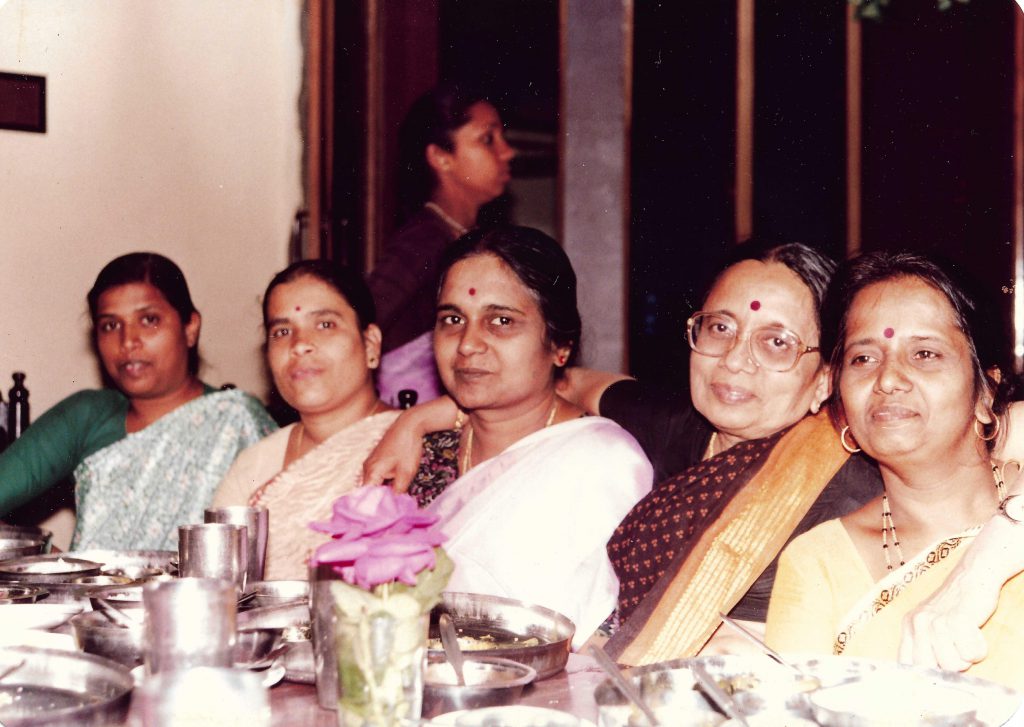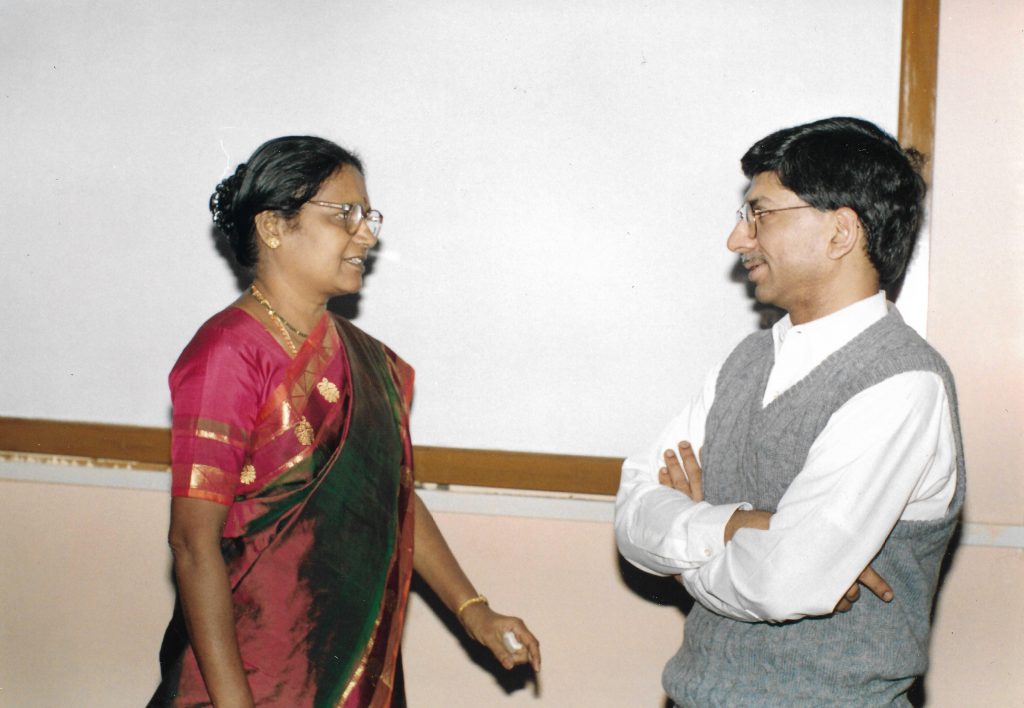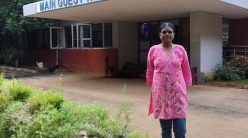
When AV Leelavathi joined IISc in 1964, her entry to the Institute was quite unplanned.
While studying at a friend’s house one day, the friend received a visit from someone who had gone to IISc to pick up an application form for the post of Stenographer for his sister. He had been given three forms, and so passed two of them on to Leelavathi and her friend. She filled out the form, and eventually she got a letter asking her to appear for a written test and was selected after an interview. Her father insisted that she join – and that was how her career at the Institute began.
Starting in administrative work, she says, was a challenge because it was “a male world” in which she was the only woman. Over the next 38 years, she worked in the Central Office (Student Section), the Department of Applied Mathematics, the Centre for Theoretical Studies, the Microbiology and Cell Biology Laboratory, and the Department of Electrical Communication Engineering before retiring in 2002. Here is an edited excerpt from an interview with her, in which she talks about attending a party at Nalini Dhawan’s house, lunchtime adventures on IISc’s campus, and more.
What was your role at the Institute?
I started my career as a Stenographer. To start with, I was in the Student Section, and my work was related to thesis submission by students for MSc and PhD degrees. I had to co-ordinate with students, faculty, examiners, and IISc’s Senate and Council. This meant direct contact with the Assistant Registrar, the Registrar, the Director’s Office, and the Finance Officer.
After that, I was transferred to the Department of Applied Mathematics.
What was the Department of Applied Mathematics like at the time?
When I was first transferred, the Registrar called and said, I am sending you there as my representative to look after the office work, don’t take sides. I did not know why he was telling me this. But as I entered the department building, a senior faculty member said, “What can we do with a lady here?” Then one more faculty member advised me to go back, because I would not survive here. I learned that things had gone wrong in the department and the Director at the time, Prof Dhawan, had taken over. I found the office empty, because they had transferred out all three people who had been there, and I was posted in their place.
I started from scratch and built up the office. Proof of this is that Prof Dhawan recommended me for – and got me – an advance increment, which was unheard of in those days. In the end when I was transferred, the whole department was against my transfer. I was given a very warm and grand party with a gift. The chairman said, “We are waiting to give you a welcome [back] party.”
Where were you transferred to?
I was transferred to the Centre for Theoretical Studies (CTS). This department was mainly involved with visitors programmes. Prof ECG Sudarshan had come as a visiting professor. There were other visiting faculty such as Dr AM Verma, who was in NIMHANS, and other eminent scientists from abroad.
Then I was transferred to the Department of Microbiology.
My time in Microbiology was the peak of my service at the Institute. I helped organise a number of international seminars and conferences. When Prince Charles visited the department, I had an important role in organising it. After visiting the silkworm lab, he wanted some sarees which he took with him.
Faculty, students, workshop staff, laboratory staff and office staff were like a joint family. We used to arrange two picnics a year – one included our actual family members, and we would prepare our own food.
Then I moved to the Department of Electrical Communication Engineering (ECE), one of the biggest departments. It was here that I was introduced to the world of computers. I learned the basics from students, and account-keeping from one of the faculty members. Though I started my career with manual typewriters, I went on to electronic typewriters and ended with electronic mail and a fully computerised office (Professor Anurag Kumar ran the ERNET project, through which computers and email were introduced). Actually the Chairman at the time had doubts about whether I would learn how to use a computer, but I did it!
You were also involved in several activities that helped people at IISc in many ways. Could you say more about them?
While in Applied Mathematics, some faculty member had once worked out a big mathematical calculation on the blackboard. In one corner they had written, “Please do not erase”. But the office had instructed the attender, who was illiterate, to clean all the blackboards while cleaning the rooms and lecture halls, and he cleaned this one too. The next day the faculty members were naturally furious. So I told all faculty members to use coloured chalk to write “Please do not erase”, and instructed the attender not to clean the black board when it had coloured writing.
But I realised this was not the solution. I asked the attender whether he would like to learn English. He said “yes”. So with waste paper and gifted pens, I started teaching him the alphabet and he learned how to write and read. I am happy to report that he became very thorough and used to help his colleagues write applications and so on, and even learned Hindi from my colleague. Each one teach one. Even now the Institute can do this by introducing an adult education programme to make 100 percent of people on this campus literate.
I am sure we retired people will volunteer to help.
When I was in the Department of Microbiology, I helped start a fund for lab helpers and attenders, and took responsibility for collecting contributions for the families of supporting staff when they died. I also joined others in petitioning for a creche at IISc as I found it difficult to look after my young son and I am happy to see that there is now more than one.

Can you tell us about your adventures exploring IISc’s campus?
Here is my experience of the height, width and depth of the Main Building. After I had been at IISc for some time, one day I noticed how high the tower of the Main Building was, and I wanted to explore it. During my lunch hour, I went with a few of my colleagues, took the key from the person in charge, opened the door leading to the tower and climbed up. I saw not only steps but ladders – shaky ones – that we needed to climb. After reaching almost to the top, there was a water tank and a very shaky ladder at the side of it, and as we climbed up, the pigeons who had made nests there started flying away. Imagine our plight on a shaky ladder, trembling – somehow we got up, opened the door and came out onto the balcony. We felt the whole tower was shaking and floating, and holding the railing with all our might, we looked out at the landscape of the city from that height. As the pigeons started flying away in large numbers, the people who were on the ground started looking up and saw us. Among them was the Registrar, who was returning after the lunch hour. We waved at him and he reciprocated. And we came down, exhausted but with the full satisfaction of achieving something huge, as if we had climbed Mount Everest. I received a message asking me to meet the Registrar, and when I went he asked how it was (of course I explained with full enthusiasm exactly how it was). Cool and calm, he said, “Don’t ever repeat this adventure.” Needless to say, the entrance to the tower stayed locked after that and the key was put in safe custody.
Another time, as usual after lunch, a colleague and I started exploring the Institute’s border. It took nearly two hours – there was no wall all around at the time, and I came back to the office very late. I had to pass through the Assistant Registrar’s room to get to my desk, so I entered his room and naturally he was not happy to see me coming so late. But immediately he noticed I was exhausted and sweating, and he offered me a seat and a glass of water and asked what happened. When I told him, he was speechless. After some time, he advised me not to venture around campus as it was not safe, and full of snakes, and so on.
Once I had the chance to visit the cellar of the main building, to get some records from there. It is huge, running the length and breadth of the main building.
What are your best memories of your time at IISc?
For me, it has been special to have served the former Director Prof Bhagavantam, a serving Director, Prof Dhawan, and a future Director, Prof Anurag Kumar. And I am happy that I was not the first person from my family to serve the Institute. My maternal uncle, Cheluvaraja Moduliar, was here as an artist. He used to write the degree certificates, has painted the scenes from the Founder’s Day celebrations, and performed a few more tasks at ECE. My brother AV Kumar joined ECE as a student, but as he got an opportunity to go to Germany he discontinued his course. My sister AV Asha Jayanthi did her research at IISc’s School of Automation and joined ISRO.
Let me tell you about life on campus outside the office.
I used to walk with Ms Sudha Murthy of Infosys when she was a student at ECE. And as the ladies’ hostel was next to our house, those students used to visit us as they used to miss their families and they enjoyed my cooking.
As I used to live on campus and would walk up and down, Mrs Nalini Dhawan became friendly with me as both of us were interested in the plants, trees and even weeds on campus. Before the Dhawans left the campus, she hosted a party for all the women faculty and wives of faculty in their bungalow. I was the only one among them who fit neither category, but she introduced me so nicely to them.
In 1964, a few women started assembling during the lunch hour under the tree at the back of the main building. Slowly women on campus from other departments and some women students joined us. We used to go to movies, mostly at Lido Theatre, on Saturdays as we had only half a day of work, and also organised some picnics to nearby places. I think this was the beginning of what is now the Ladies’ Club.
I not only worked at the Institute, I lived and breathed it all through the 38 years of my service. When I joined I was the only woman in the Administrative Section. Though one more woman joined soon after, she left in a little while. But now, I see ladies everywhere. Proof of women power. ‘His-story’ is always there but ‘Her-story’, the lady stars, should always shine bright and show the way.
How have you been spending time after retirement?
This was the big question I had. But one of my friends at church suggested that I do social service. I take a very active role in this. I attended Bible classes at St Peter’s Pontifical Seminary and one of the priests there asked me, you are from a nearby institute, how is religion practised there? I said, “There is no religion there, people are there from all over the world. All are one.” He was astonished.
Once again I am thankful. The Institute is taking care of my health and wealth. I no longer call IISc ‘Tata Institute’, but ‘Thaatha mane’ [grandfather’s house].




